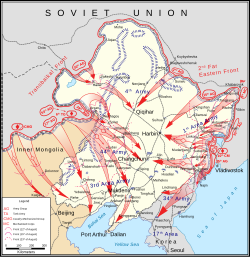Soviet occupation of Manchuria
Soviet occupation of Manchuria | |
|---|---|
| 1945–1946[a] | |
|
Flag of the Soviet Union (1936–1955) | |
 Soviet gains in North East Asia, August 1945 | |
| Status | Soviet occupation |
| Capital | Shenyang (Command Station) |
| Common languages | Chinese (Northeastern Mandarin) Japanese Russian |
| Soviet commander | |
• 1946 | Rodion Malinovsky |
| History | |
• Soviet troops invaded Manchuria | 9 August 1945 |
• Withdrawal of all Soviet troops in Manchuria | 3 May 1946[a] |
| Currency | Yuan |
| Time zone | UTC+8 |
| Today part of | China Russia |
The Soviet occupation of Manchuria took place after the Red Army invaded the Empire of Japan's puppet state of Manchukuo in August 1945; the occupation would continue until Soviet forces withdrew in May 1946.
History
[edit]On 11 February 1945, the Big Three (Roosevelt, Churchill, and Stalin) signed the Yalta Agreement. Yalta obligated the Soviet Union to enter the war against Japan within three months after Germany's surrender, in exchange for territorial concessions and Soviet influence in post-war Manchuria.

Stalin ordered the invasion of Manchukuo on 9 August 1945, according to conditions of Tehran Conference and inaugurated in one of the largest campaigns in the Second World War. The massive Red Army steamrolled into Manchuria, brushing aside scattered Japanese resistance, and occupied Mengjiang (Inner Mongolia), southern Sakhalin, and the northern half of the Korean peninsula as well. The rapid defeat of the Kwantung Army in Manchuria, along with the recent atomic bombing of Hiroshima and Nagasaki by the Americans, contributed significantly to the Japanese surrender on the 15th.[1][2][3][4]
The invasion, along with the surrender, prompted the Kuomintang to jockey for position vis-a-vis the Chinese Communist Party (CCP) in mainland China. The Kuomintang signed the Treaty of Friendship and Alliance with the Soviet Union on 14 August 1945, which affirmed Chinese sovereignty over Manchuria in exchange for Chinese recognition of the Soviet-aligned Mongolian People's Republic.[citation needed]
The combined impact of the Soviet invasion and the atomic bombings left Japan little room for maneuver. On August 15, 1945, Emperor Hirohito announced Japan's unconditional surrender to the Japanese people over radio, marking the end of World War II.[5]
In September 1945, the CCP dispatched soldiers to Soviet-occupied Manchuria.[6]: 73 The CCP obtained Japanese arms with Soviet help.[6]: 73 The Soviet stance regarding the CCP and the Chinese Nationalists oscillated during this period, and in November 1945 the Soviet Union requested that the CCP withdraw from major cities in Manchuria.[6]: 73 Chiang Ching-kuo met with Stalin in January 1946 on the issue, and Stalin contended that the Soviet Army had shed blood in defeating the Japanese in Manchuria and therefore Japanese enterprises which had served the Kwantung army should be treated as trophies for the Red Army.[6]: 80
Between September and November 1945, the Soviet Union removed machinery from Japanese industrial plants in Manchuria and took them for use in the Soviet Union.[6]: 73
The Soviets began withdrawing from Manchuria within three weeks of Japan's surrender, although they would delay the process several times. The resumption of the Chinese Civil War in early 1946 prompted the Red Army to finish the withdrawal,[7] but not before secretly turning much of Manchuria over to the CCP in March in violation of the Agreement.[8]
See also
[edit]References
[edit]Note
[edit]- ^ Occupation of Lüshun base until 1955
Citations
[edit]- ^ Robert Butow, Japan's Decision to Surrender, Stanford University Press, 1954 ISBN 978-0-8047-0460-1.
- ^ Richard B. Frank, Downfall: The End of the Imperial Japanese Empire, Penguin, 2001 ISBN 978-0-14-100146-3.
- ^ Robert James Maddox, Hiroshima in History: The Myths of Revisionism, University of Missouri Press, 2007 ISBN 978-0-8262-1732-5.
- ^ Tsuyoshi Hasegawa Archived 24 September 2015 at the Wayback Machine, Racing the Enemy: Stalin, Truman, and the Surrender of Japan, Belknap Press, 2006 ISBN 0-674-01693-9.
- ^ "VJ Day: Japan surrenders, ending WWII with Emperor Hirohito radio address - The Washington Post". The Washington Post. Archived from the original on 14 August 2020. Retrieved 23 December 2024.
- ^ a b c d e Hirata, Koji (2024). Making Mao's Steelworks: Industrial Manchuria and the Transnational Origins of Chinese Socialism. Cambridge Studies in the History of the People's Republic of China series. New York, NY: Cambridge University Press. doi:10.1017/9781009382281. ISBN 978-1-009-38227-4.
- ^ 作者:劉向上 (20 April 2009). "张莘夫事件"与苏军撤出东北 (in Chinese). 揚子晚報網. Archived from the original on 1 November 2013. Retrieved 20 April 2009.
- ^ "Manchuria - Imperialism, Japanese Occupation, Cold War | Britannica". www.britannica.com. Retrieved 18 March 2024.


